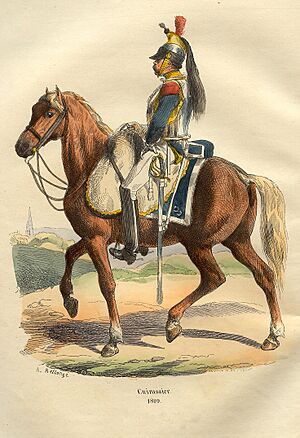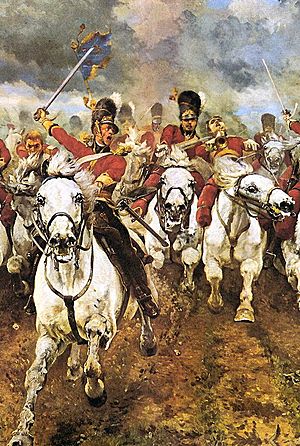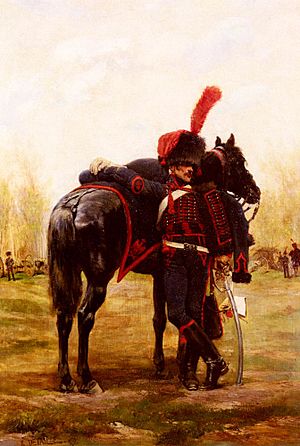Horses in the Napoleonic Wars facts for kids
Horses were super important during the Napoleonic Wars (1803-1815). They were used for fighting, scouting, and moving supplies. Huge numbers of horses helped armies throughout these wars.
For example, during the Waterloo Campaign, the French army had about 47,000 horses! About 25,000 were for cavalry (soldiers on horseback). Another 12,000 pulled cannons, and 10,000 helped move infantry (foot soldiers) and supplies. Losing many horses, especially during the Russian Campaign, made it harder for the French army to win battles. This loss of horses was a big reason for the French Empire's defeat.
Contents
Cavalry: Soldiers on Horseback
Cavalry were soldiers who fought on horseback. Their main job in a battle was to charge the enemy. This was called a 'shock' action. Cavalry charges were carefully planned. They usually moved at about 20 kilometers per hour (about 12 miles per hour). Going faster would make the horses too tired and break up the formation.
One famous charge was by the Royal Scots Greys at Waterloo. They rode over a hill and straight into the French army. It was so close that they "walked over" the enemy soldiers.
Cavalry charges often happened on open, slightly uphill ground. The cavalry would line up or form columns. Sometimes, horse artillery (cannons pulled by horses) would go with them. Infantry (foot soldiers) often followed to hold any ground won.
If an enemy army started to retreat, cavalry would chase them. This helped to make sure the enemy was truly defeated. Cavalry could also attack the sides of enemy infantry lines as they moved forward. They were also used to break up enemy lines after infantry had attacked successfully.
Cavalry Against Infantry
Cavalry were very good at attacking infantry soldiers who were marching or in lines. A line of infantry was very weak against a strong cavalry charge. For example, at the Battle of Albuera in 1811, a British brigade (a group of soldiers) was almost completely destroyed by a cavalry charge. They lost 1,250 out of 1,650 men!
To protect themselves, infantry soldiers would form a square. This was a tight, four-sided formation. It presented walls of muskets and bayonets on all sides. This made it very hard for cavalry to break through. However, squares were easy targets for cannons or other infantry. Cavalry often charged before an infantry attack. Their goal was to force the enemy infantry into squares, making them vulnerable to cannons or other foot soldiers.
Artillery: Horse-Powered Cannons
Horses were also very important for pulling heavy cannons and supply wagons. This was called "draught" work.
Besides regular field artillery (where gunners walked), armies also had horse batteries. In horse artillery, every gunner had their own horse. This made them much faster. Horse artillery usually used lighter cannons. However, the British had some medium-weight cannons (9-pounders) that were pulled by 8 horses instead of 6 for extra speed. Heavy cannons needed a team of 12 horses!
A single artillery battery (a group of six cannons) could need 160 to 200 horses. This included horses for officers, doctors, and other support staff, as well as those pulling the cannons and wagons. Horses for artillery needed to be strong and quick. The best artillery horses were about 15 to 16 hands high (a way to measure horse height).
Horse artillery often supported cavalry units. They were usually part of cavalry divisions. At the Battle of Waterloo, the British used horse artillery as a fast-response team. They helped stop French attacks and even helped the infantry recapture a key position called La Haye Sainte.
Horse Types and Breeds

War horses were usually not too big. Very large horses were hard to feed and care for. They also didn't do as well on different types of land. Most armies preferred cavalry horses to be about 15.2 hands tall and weigh between 450 and 500 kilograms (about 990-1,100 pounds).
Different types of cavalry used different sized horses:
- Cuirassiers (heavy cavalry) used horses taller than 15.3 hands.
- Dragoons (medium cavalry) used horses from 15.0 to 15.3 hands.
- Hussars (light cavalry) used horses around 14.2 hands.
- Chasseurs à cheval (light cavalry) used horses between 14.3 and 15 hands.
Smaller, lighter horses were used for scouting and quick raids.
Horses were usually bought when they were 5 years old. They could serve for 10 to 12 years if they didn't get sick or hurt. Mares (female horses) and geldings (male horses that cannot reproduce) were preferred over stallions (male horses that can reproduce) because they were easier to manage.
It was common for armies to lose 30-40% of their horses during a campaign. This was due to a lack of food, tough marching conditions, and enemy attacks.
Some regiments (groups of soldiers) chose horses of a similar type. For example, the Royal Scots Greys only used grey horses. Trumpeters (musicians who played trumpets) often rode horses of a special color, like grey, so they would stand out. Different regions also had their favorite horse breeds. The British liked 15-hand hunters, the Germans used Hanoverians, and the Prussians used Trakehner horses. The Cossacks, from Eastern Europe, used their tough steppe ponies.
See also
- Horses in warfare
- Types of military forces in the Napoleonic Wars




